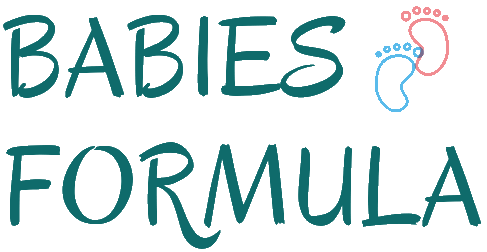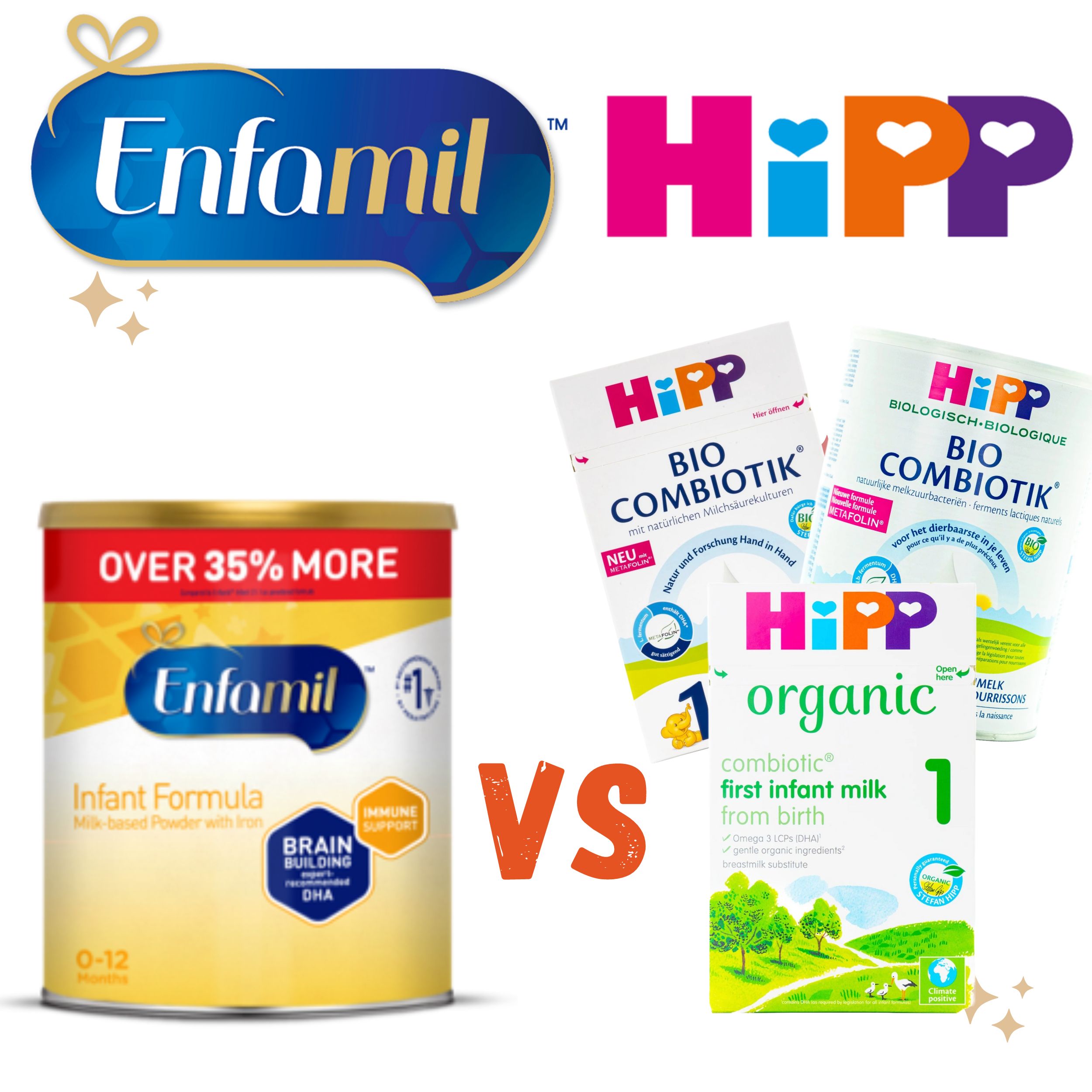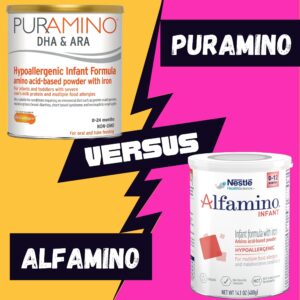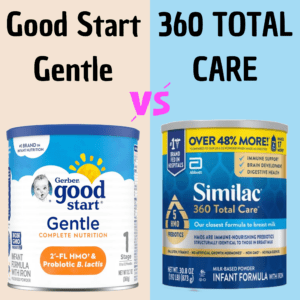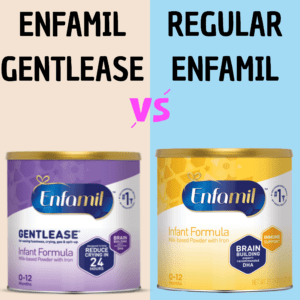Enfamil Infant has one formula for the first year but HiPP has two formulas; Infant formula for babies between 0-6 months and Follow-on formula for babies between 6-12 months, That’s why we will see two comparisons; one between HiPP (0-6 months) and Enfamil Infant, the seconde between this last and HiPP (6-12 months).
Comparison Chart (0-6 months):

“When you buy something using my links, I may earn a small commission at no additional cost to you. This is a kind of support to me. This website doesn’t accept money for reviews. “
The main points of difference between Enfamil Infant and HiPP (0-6 months) are:
- GMO Status:
Enfamil Infant is not branded as GMO-Free because it contains some GMO ingredients whereas HiPP is GMO-Free. HiPP is committed to using non-genetically modified ingredients, which may be appealing to parents concerned about GMOs in their baby’s diet.
- Starch, and Soy:
HiPP (0-6 months) is Generally soy-free and starch-free with some exceptions (e.g., the German version contains lactose and starch as carbohydrate sources). The starch-free option might be preferred by parents looking to minimize starch intake in their baby’s diet. In contrast, Enfamil Infant is starch-free but it has soy oil within fat sources.
HiPP German has another formula in this stage called PRE which is soy-free and starch-free. I made a full comparison between HiPP German stages (PRE – Stage 1 – Stage 2 – Stage 2 (No starch) – Stage 3) if you want to check.
- Organic Ingredients:
Enfamil Infant Doesn’t have organic ingredients while HiPP Contains organic ingredients that are EU organic certified. This can be attractive to parents who prioritize organic and natural ingredients in their baby’s formula.
- Probiotic:
Enfamil Infant doesn’t have a probiotic. However, HiPP (0-6 months) Contains a probiotic called L. fermentum, except for the UK version. Probiotics may help support a baby’s developing digestive system.
- Regulatory Approval:
Enfamil Infant is FDA Approved, which may provide added assurance to some parents about its safety and quality whereas HiPP (0-6 months) is not FDA Approved, as it is primarily marketed and regulated in the European Union. However, it does comply with EU organic standards.
- Geographical Availability:
Enfamil Infant is available in the United States and other markets while HiPP is available in Europe and some international markets but not in the USA.

Ingredients Comparison (0-6 months):

Protein Source:
When considering the protein composition, Enfamil Infant utilizes a blend of 50% nonfat milk and 50% whey protein concentrate, with a consistent whey-to-casein ratio of 60:40. This mixture offers a balanced protein source, taking advantage of the digestibility benefits of whey protein. In contrast, HiPP (0-6 months) draws its protein from organic sources, specifically using a combination of organic skim milk (nonfat milk) and whey protein. The whey-to-casein ratio of 60:40 remains intact in HiPP’s formula as well.
Both formulas aim to provide infants with crucial protein nutrients, but HiPP places an emphasis on organic production for its protein sources. This distinction allows parents to weigh factors such as protein origin, digestibility, and organic practices when making an informed choice for their baby’s nutritional needs.
Carbohydrate Source:
In terms of carbohydrate sources, Enfamil Infant relies on lactose as its carbohydrate foundation. In contrast, HiPP (0-6 months) predominantly utilizes organic lactose for its carbohydrate content, underscoring its commitment to organic practices. Notably, the German version of HiPP incorporates a blend of lactose and starch as its carbohydrate sources.
This distinction highlights HiPP’s adherence to organic standards in its carbohydrate sources, except for the specific German variant.
Related: HiPP German Vs Dutch Vs UK: What’s The Difference?
Fat Source:
When comparing fat sources, Enfamil Infant incorporates a mix of palm oil, high oleic safflower oil, soy oil, and coconut oil to provide its fat content. In contrast, all HiPP formulas, including HiPP (0-6 months), exclusively use a combination of organic palm oil, organic rapeseed oil, and sunflower oil.
This distinction highlights HiPP’s commitment to using organic and varied plant-based oils for its fat composition. While Enfamil draws from a diverse range of fat sources, HiPP maintains a consistent organic approach across its formula lineup.
Prebiotics:
Both formulas have the Galactooligosaccharides (GOS) prebiotic, but Enfamil Infant has another one called polydextrose. These prebiotics are important because they promote gut health and digestive comfort by being food for good bacteria (probiotics).
Probiotics:
Enfamil Infant doesn’t have a probiotic whereas all HiPP formulas have one called L. Fermentum except the UK version. Probiotics are live microorganisms, often referred to as “good” or “friendly” bacteria, that provide potential health benefits when consumed in adequate amounts. Probiotics are commonly associated with promoting a healthy balance of gut bacteria and supporting various aspects of digestive and immune health
Related: HiPP Combiotic VS Gerber Good Start Gentle: Which One to Choose?
Nutrient Comparison (0-6 months):

Micronutrients:
In terms of micronutrients, Enfamil Infant is enriched more than HiPP (0-6 months) formulas with Protein and Carbohydrate while HiPP (0-6 months) formulas are fortified slightly with fat.
Vitamins:
Regarding vitamins, Enfamil Infant has more Vitamin A, Vitamin E, Vitamin K, Vitamin B1, Vitamin B6, Vitamin B12, Niacin, Folic acid, and Biotin than HiPP (0-6 months) formulas while this last has more Vitamin D, Vitamin B2, Pantothenic acid, Vitamin C, Choline, and Inositol.
Related: Enfamil Neuropro Vs. Enfamil Infant: Full Comparison
Minerals:
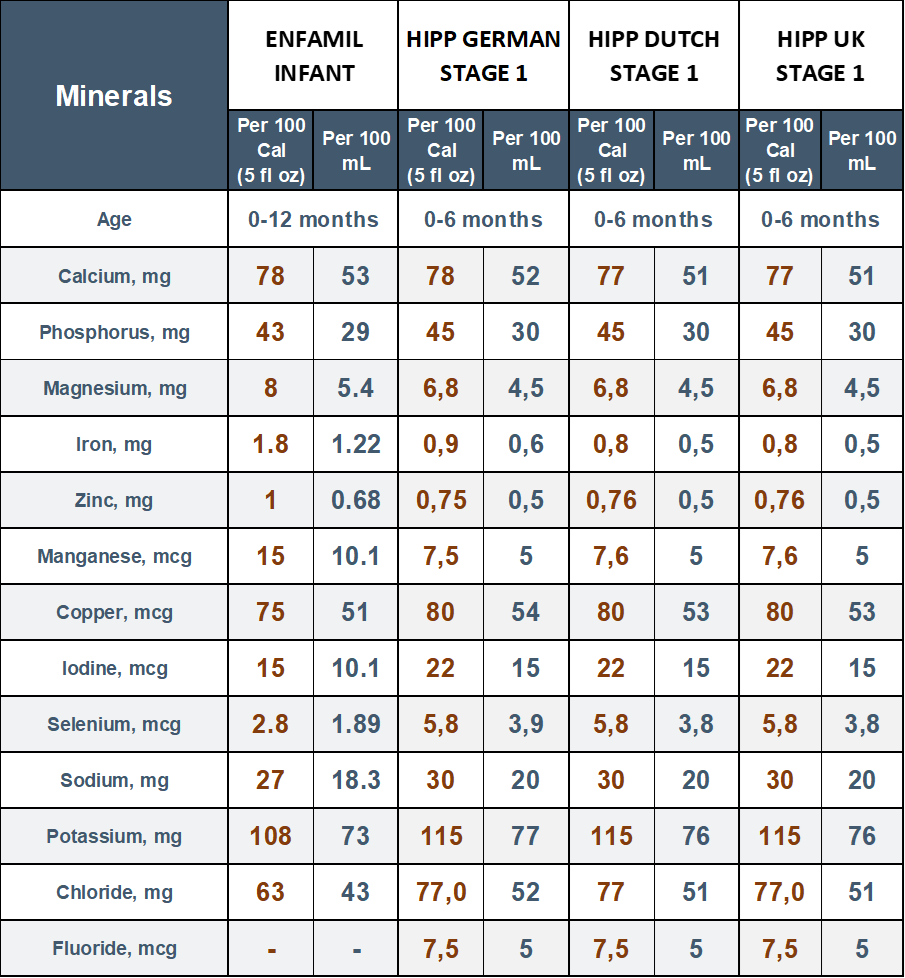
In terms of mineral content, Enfamil Infant formula is notable for its higher levels of magnesium, iron, zinc, and manganese, which are essential for various aspects of infant growth and development. However, it does not contain fluoride. On the other hand, HiPP (0-6 months) formulas are characterized by their elevated levels of copper, iodine, selenium, sodium, potassium, chloride, and fluoride.
These minerals play crucial roles in supporting overall health, including thyroid function, immune system development, electrolyte balance, and dental health due to the inclusion of fluoride.
Related: HiPP Combiotic VS Similac Advance & Pro Advance: Which One is The Best?
Price Comparison (0-6 months):

In terms of price, Enfamil Infant is way cheaper than HiPP (0-6 months) formulas. Enfamil Infant is available in multiple sizes and forms (powder and liquid), the cheapest powder can is 21.1oz which costs $1.2 /oz. On the other hand, HiPP formulas are available only in one size; 600 g (21.16 oz) for German and 800g (28.22 oz) for Dutch and UK versions.
Enfamil Infant formula being cheaper than HiPP formulas can be attributed to factors such as differences in ingredients, production scale, brand positioning, distribution networks, certification costs, and regional market dynamics.
HiPP’s focus on organic and premium ingredients, along with its smaller scale and branding, can contribute to its higher price point. Additionally, Enfamil’s larger production volume and broader market reach might enable cost efficiencies.
Related: HiPP VS Bobbie: Which One is The Best?
Where to Buy?
HiPP (0-6 months):
| Formula | Where to Buy? |
|---|---|
| HiPP German Stage 1 | Buy HERE |
| HiPP German PRE RTF | Buy HERE |
| HiPP Dutch Stage 1 | Buy HERE |
| HiPP UK Stage 1 | Buy HERE |
Enfamil Infant:
Comparison Chart (6-12 months):
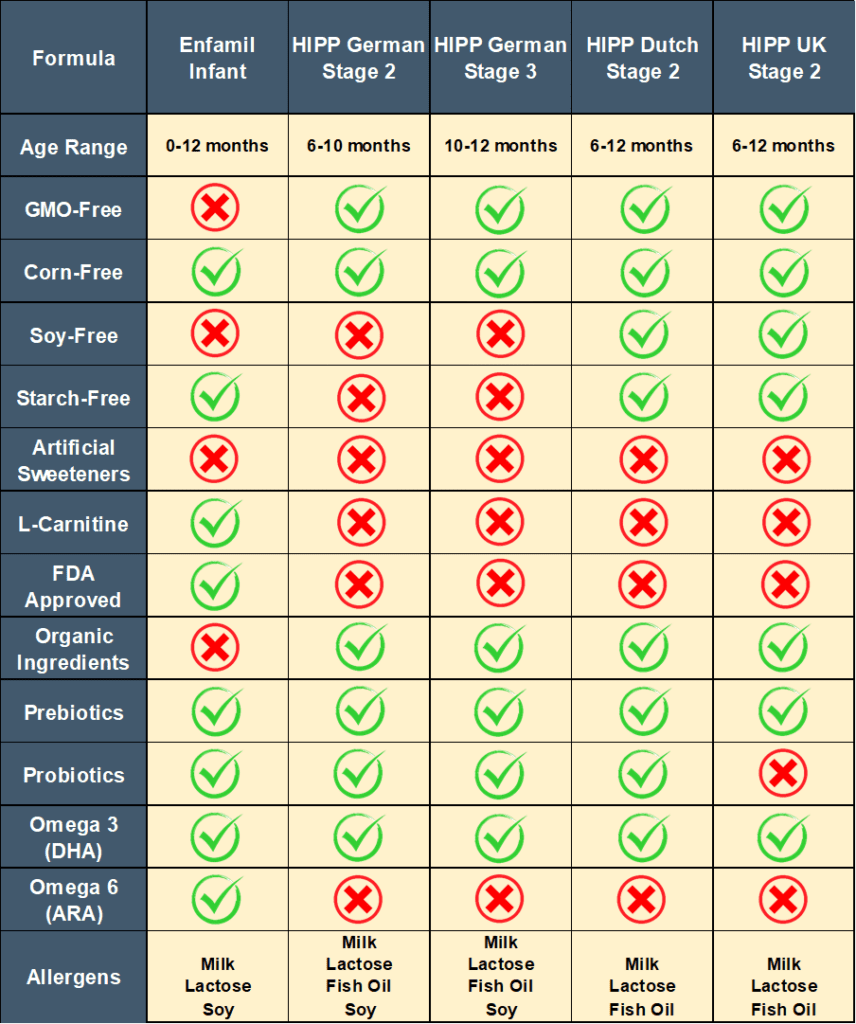
Enfamil Infant formula is not branded GMO-Free because it has some GMO ingredients and is formulated to be corn-free and starch-free. It provides babies with L-carnitine from 0 to 12 months and includes two prebiotics to support gut health. However, it does not include probiotics. Enfamil Infant does contain both DHA and ARA, which are essential fatty acids important for infant development. Additionally, it is FDA-approved, meeting the regulatory standards set by the United States.
In contrast, HiPP (6-12 months) formulas are GMO-free, which means they do not contain genetically modified ingredients. They are predominantly soy-free and starch-free, except for the German version, which contains Emulsifier Lecithins and has lactose and starch as carbohydrate sources. HiPP formulas do not provide L-carnitine from 6-12 months.
HiPP German has another formula in this stage called Stage 2 (No starch) which is soy-free and starch-free.
They are not FDA-approved, as they are primarily marketed in Europe and are subject to European organic and safety standards. HiPP formulas stand out for their use of organic ingredients, which are certified by the European Union. They also contain prebiotics for digestive health and probiotics in most versions, except the UK variant. HiPP formulas include DHA, although they do not contain ARA.
Ingredients Comparison (6-12 months):
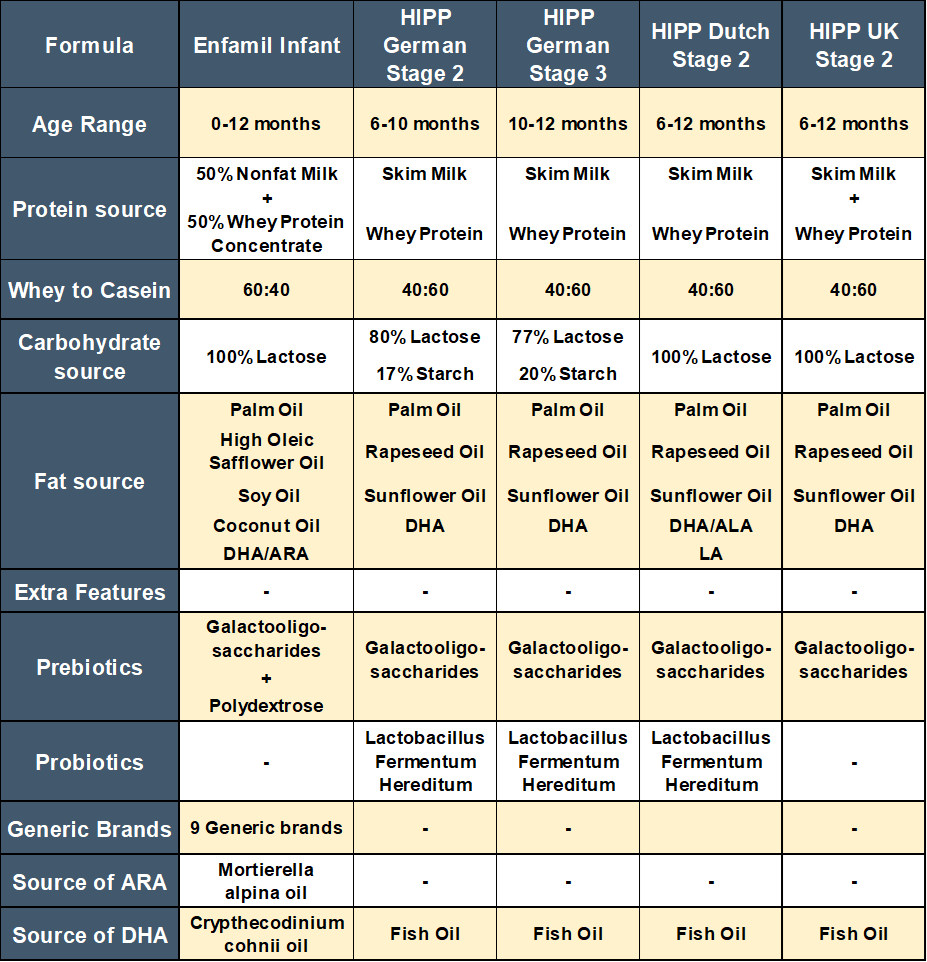
Protein Source:
Both Enfamil Infant and HiPP (0-6 months) formulas utilize a combination of skim milk and whey protein as their protein sources. However, there is a distinct difference in the whey-to-casein ratio between the two formulas. Enfamil Infant formula maintains a whey to casein ratio of 60:40, favoring a higher proportion of whey protein. In contrast, HiPP (0-6 months) formulas have a reversed ratio of 40:60, with a higher concentration of casein protein.
Furthermore, HiPP (0-6 months) formulas are characterized by their use of organic ingredients. This organic certification extends to protein sources, reflecting HiPP’s commitment to providing a formula with organic components.
Related: The Best 9 Generic Brands of Enfamil Infant Formula
Carbohydrate Source:
Enfamil Infant formula relies on lactose as its carbohydrate source. In contrast, HiPP formulas for the 6-12 months age range primarily use organic lactose as their carbohydrate source. However, it’s noteworthy that the German version of the HiPP formula in this age range incorporates a combination of both lactose and starch as its carbohydrate sources.
Fat Source:
Enfamil Infant formula derives its fat content from a blend of palm oil, high oleic safflower oil, soy oil, and coconut oil. This mix of oils contributes to the overall fat profile of the formula, providing a blend of different fatty acids to support infant growth and development. Also, it includes both DHA (docosahexaenoic acid) and ARA (arachidonic acid), which are essential fatty acids.
On the other hand, HiPP formulas designed for the 6-12 months age range adhere to a specific fat composition. These formulas utilize a trio of organic fat sources: organic palm oil, organic rapeseed oil, and sunflower oil. These organic oils are selected to provide a balanced and wholesome fat content for growing infants. It’s worth mentioning that while HiPP formulas incorporate DHA to support neurological and visual development, they do not include ARA.
Prebiotics/Probiotics:
Enfamil Infant has two prebiotics to help gut health which are Polydextrose and Galactooligosaccharides (GOS) whereas HiPP (6-12 months) formulas have one prebiotic called Galactooligosaccharides (GOS) and one probiotic called L. fermentum.
Nutrient Comparison (6-12 months):
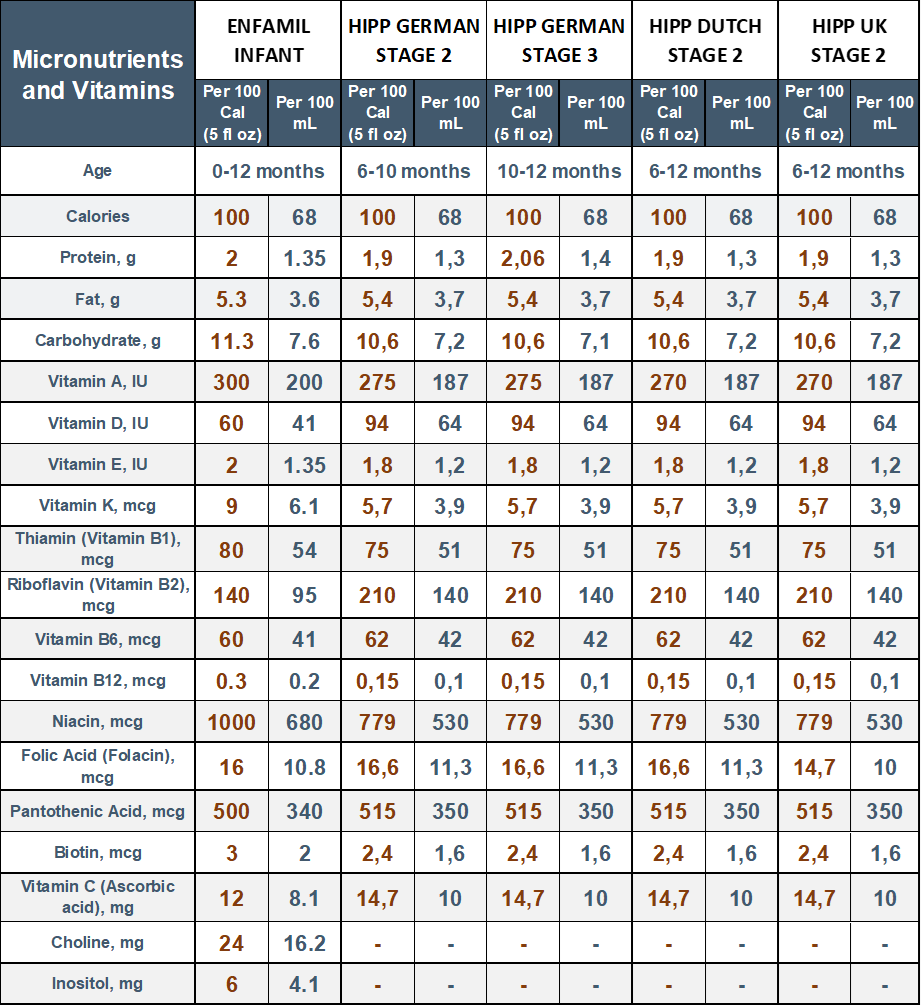
Micronutrients:
Enfamil Infant formula boasts higher enrichment levels of carbohydrates compared to HiPP (6-12 months) formulas. The elevated carbohydrate content in Enfamil aims to provide infants with essential energy and sustenance during this critical growth phase. In contrast, HiPP (6-12 months) formulas focus on a slight fortification of fat, which contributes to the formulation’s overall nutritional balance.
Vitamins:
Enfamil Infant formula features higher levels of certain vitamins, including Vitamin A, Vitamin E, Vitamin K, Vitamin B1, Vitamin B12, Niacin, and Biotin, providing a comprehensive spectrum of essential nutrients to support infant growth and development.
In contrast, HiPP (6-12 months) formulas offer elevated amounts of different vitamins, such as Vitamin D, Vitamin B2, Vitamin B6, Folic acid, Pantothenic acid, and Vitamin C. These vitamins play vital roles in promoting bone health, energy metabolism, and immune function during this stage.
However, there are some distinctions to note. HiPP (6-12 months) formulas do not contain Choline and Inositol, which are important nutrients for brain development and overall health.
Minerals:
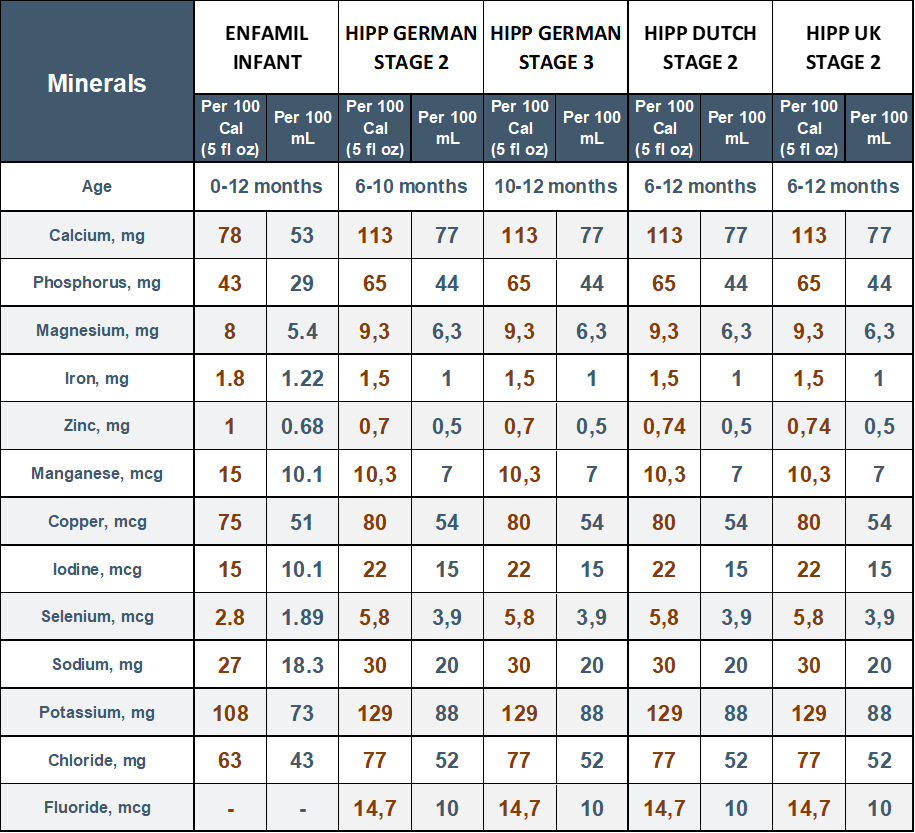
Enfamil Infant formula is notable for its elevated levels of iron, zinc, and manganese, key minerals that support various aspects of infant development, including growth and immune function.
On the other hand, HiPP (6-12 months) formulas stand out for their higher levels of calcium, phosphorus, magnesium, copper, iodine, selenium, sodium, potassium, chloride, and fluoride. These minerals play crucial roles in bone and teeth health, nerve function, electrolyte balance, and overall well-being during this developmental stage.
Price Comparison (6-12 months):

Same thing for 0-6 months formulas, Enfamil Infant is way cheaper than HiPP (6-12 months), but the difference here is that most HiPP Follow-on formulas don’t have a liquid form except the UK version.
Where to Buy?
HiPP (6-12 months):
| Formula | Where to Buy |
|---|---|
| HiPP German Stage 2 | Buy HERE |
| HiPP German Stage 3 | Buy HERE |
| HiPP Dutch Stage 2 | Buy HERE |
| HiPP UK Stage 2 | Buy HERE |
Enfamil Infant:
The Best One?
The decision between Enfamil Infant and HiPP formulas hinges on a blend of factors, each tailored to individual priorities and circumstances. Enfamil Infant formula offers accessibility, cost-effectiveness, and an enriched vitamin profile, making it a viable choice for many families. However, the absence of GMO-free and soy-free options might be a concern for some.
On the other hand, HiPP formulas, renowned for their commitment to GMO-free and soy-free ingredients, present a premium choice. The incorporation of organic ingredients aligns with a preference for natural sourcing, although the higher cost may influence the decision. Additionally, HiPP formulas’ mineral-rich content contributes to comprehensive nutritional support.
Ultimately, geographic availability also plays a role; Enfamil Infant formula is accessible in various markets, including the United States, whereas HiPP formulas are not available in the USA.
In essence, the best formula choice varies for each family. Enfamil Infant formula might be suitable for those seeking affordability and enriched vitamins, while HiPP formulas resonate with those valuing GMO-free, organic ingredients, and a mineral-rich profile.
